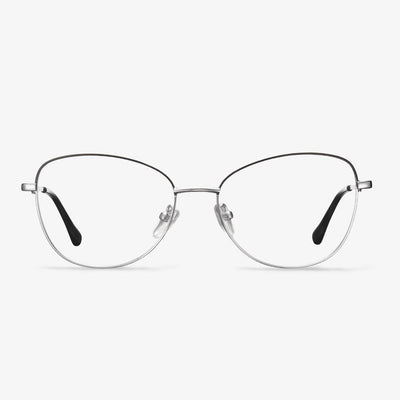What kind of glasses can people with round faces choose?
Always thought, like what has been said on the Internet, if you wear black frame glasses with large lenses, they can make you look small on the face. This is a mistake, because the black frames are too obvious, creating the wrong area on your face where the glasses are too small.
And for this kind of rimless glasses, because the bottom part is transparent, they will not destroy the partition, and you will feel the face is pretty sharp. For a man with a round face, the appropriate choice is a flat or pear-shaped frame. For a woman with a round face, in principle, she should avoid choosing any very obvious characteristics of the frame, and should not choose a too round or straight-line frame. Round faces are suitable for slender or square frames or pear-shaped frames. The human face of a round face is shorter, so, they had better match the slender glasses frame that takes curve slightly to reconcile the whole feeling. The square glasses or the frame with angle, are helpful for modifying the facial ministry line, highlighting the longitudinal line.
Are blue light glasses good for driving at night?
Are blue light glasses helpful when driving at night? The answer is not necessarily. Anti-reflective coating on glasses is beneficial. But blue light blocking won't have any effect on your driving at night. If your glasses have an anti-reflective coating, then they might be helpful for night driving. Otherwise, they won't have any impact.
Driver's protective glasses
The principle of the driver's protective glasses is to use the special film on the glasses to reflect the strong light hitting the glasses back to protect the eyes. It can protect against ultraviolet, infrared and blue light on foggy and rainy days. In snowy weather and at night, the wearer can see the scenery more clearly, and it can also increase the vividness of red, yellow, green, white, and other colors, and eliminate the glare and reflected light of the oncoming cars when meeting cars at night.
How many degrees of myopia do I need to wear glasses?
Students are the most nearsighted because they need to read and study every day. Many people have myopia during their student days. During the physical examination, everyone will check their eyesight first. Generally speaking, if the visual acuity is lower than 0.6, it means that you may be near-sighted to 0 degrees. At this time, you need to go for optometry to see the specific vision situation and see if you need to wear glasses. If the visual acuity tested exceeds 200 degrees, you must wear glasses at this time. If you do not wear glasses, your vision will be greatly affected, and the degree of myopia will rise quickly. For this reason, you must wear glasses in time to correct your vision. If the degree of myopia does not exceed 0 degrees, this is pseudo-myopia and does not require glasses. However, you should always take care to protect your eyes, avoid staring at things at close range for a long time, and don't let your eyes get too tired, so your vision will slowly return to normal.
What Are Progressive Lenses?
Traditional eyeglasses are usually single vision lenses with one prescription. Progressive lenses are multiple with three prescriptions in a pair of eyeglasses. Progressive lenses let you see comfortably at different distances, allowing you to see close, near, and far without changing your glasses. There are other kinds of multifocal lenses like bifocals and trifocals, but progressive lenses differ because of their smooth transition between prescriptions.
Bifocals and trifocals work similarly to progressive lenses and feature either two or three prescriptions in a pair of glasses. These lenses have definitive lines separating the prescriptions. However, progressive lenses don’t use these lines and allow you to easily transition between prescriptions.
Hence, in the following section, we will show you 6 different types of progressive lenses.
What is hard coating on lenses?
Lenses are mainly added in two kinds of film: anti-reflection film and hard film (and some manufacturers produce anti-fogging film and mirror film, but not common). The anti-reflective film is mainly by coating the front surface of the lens with multiple layers of transparent materials with different refractive index and thickness to reduce the excess reflected light on the surface of the lens, by using the principle of light interference. The film can be applied to both glass and resin lenses. The way of hard film plating is usually a soaking process. After many times of soaking and cleaning, soaking in an organic solution containing ultrafine silicon element for a certain time, and then keeping it at a certain temperature for 4-5 hours, the fixed polymerization process of the film has been completed. The surface wear resistance of CR-39 coating can be increased by 2-4 pH, which is similar to the hardness of optical glass lenses.
Contact Lens Material - PHEMA material
It is the earliest material used in the production of contact lens hydrophilic material. The main advantage is water absorption, with a water content of about 38%. The material is soft, but its disadvantage is only partial oxygen permeability.


















































